Keywords
|
| Multiple access interference (MAI), interleavers, chip reliability estimator (CRE), decoder (DEC) & interleave-division multiple-access (IDMA). |
INTRODUCTION
|
| Recently, extensive investigations have been carried out into the implantation and applications of interleave-division multiple-access (IDMA) system as an air interface multiple access scheme. It appears that IDMA is emerging as the strongest candidate for the third generation wireless personal communication systems. A lot of research and development (R&D) projects in the field of IDMA have been going on all over the world. It then seems that IDMA will be an appropriate answer to the question: “What will the multiple access schemes for IMT-2000 / UMTS be?”. |
| Emerging requirements for higher rate data services and better spectrum efficiency are the main drivers identified for the third generation mobile radio systems. The main objectives for the IMT-2000 air interface can be summarized as |
| ïÃâ÷ full coverage and mobility for 144 kbps, preferably 384 kbps, |
| ïÃâ÷ limited coverage and mobility for 2 Mbps, |
| ïÃâ÷ high spectrum efficiency compared to existing systems, and |
| ïÃâ÷ high flexibility to introduce new services. |
A. Concept of IDMA
|
| The performance of conventional CDMA systems [1] is limited by multiple access interference (MAI), as well as intersymbol interference (ISI). Also, the complexity of CDMA multiuser detection has always been a serious concern. The problem can be seen from the angle of computational cost as well complexity of multiuser detection algorithms. The use of signature sequences for user separation is a characteristic feature for a conventional CDMA system. Interleaving is usually placed between forward error correction (FEC) coding and spreading and is traditionally employed to combat the fading effect. The possibility of employing interleaving for user separation in CDMA systems is briefly mentioned in [1] but the receiver complexity is considered as a main obstacle. In [3][4], a performance improvement achieved by assigning different interleavers to different users in a CDMA system is demonstrated. In [2], multiuser detection in narrowband applications with a small number of users is investigated. |
| A conventional random waveform CDMA (RWCDMA) system (such as IS-95) involves separate coding and spreading operations. Theoretical analysis shows that the optimal multiple access channel (MAC) capacity is achievable only when the entire bandwidth expansion is devoted to coding. This suggests combining the coding and spreading operations using low-rate codes to maximize coding gain. But separation of users without spreading operation is not feasible in CDMA. |
B. Introduction to IDMA
|
| This paper presents an asynchronous interleave-division multiple-access (IDMA) scheme for spread spectrum mobile communication systems, in which users are distinguished by different chip-level interleavers instead of by different signatures as in a conventional CDMA system incorporating the principle explained in [5][6]. The scheme considered is a special case of CDMA in which bandwidth expansion is entirely performed by low-rate coding. For convenience, it may be referred as interleave-division multiple-access (IDMA) [7][6]. This scheme inherits many advantages from CDMA such as dynamic channel sharing, mitigation of cross-cell interferences, asynchronous transmission, ease of cell planning, and robustness against fading. It also allows a low complexity multiple user detection techniques applicable to systems with large numbers of users in multipath channels. In this paper, an effort has been made to study of proposed IDMA scheme by different researchers. A very low-cost chip-by-chip iterative detection algorithm is explained with complexity independent of user number and increasing linearity with the path number. The advantages of using low-rate coded systems are demonstrated analytically. We will show that the proposed IDMA scheme can achieve performance close to the capacity of a multiple access channel. |
II. IDMA TRANSMITTERS & RECEIVER PRINCIPLES
|
A. Transmitter Structure [8]-[12]
|
| The upper part of Fig. 1 shows the transmitter structure of IDMA with K users. The input data sequence dk of user k is encoded using a low-rate code C, generating a coded sequence ck ≡ [ck (1), …, ck (j), …, ck (J)], where J is the frame length. The elements in ck are then fed to an interleaver producing xk ≡ [xk (1), …, xk (j), …, xk (J)]. The elements in ck and xk are called “chips” [13]. Users are solely distinguished by their unique interleavers. We assume that the interleavers are generated independently and randomly. These interleavers disperse the coded sequences so that the adjacent chips are approximately uncorrelated [10][11]. |
B. Receiver Structure [8]-[12]
|
| The receiver structure consists of an elementary signal estimator (ESE) and K single-user a posteriori probability (APP) decoders (DECs). The multiple access and coding constraints are considered separately in the ESE and DECs. The outputs of the ESE and DECs are extrinsic log-likelihood ratios (LLRs) about {xk(j)} defined below [11] -[14]: |
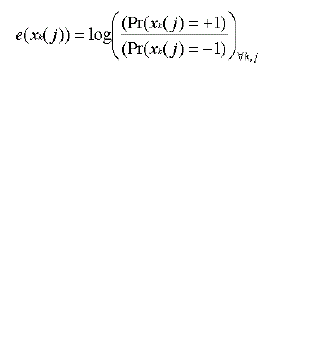 |
| These LLRs are further distinguished by subscripts, i.e., eESE (xk(j)) and eDEC (xk(j)), depending on whether they are generated by the ESE or DECs. A global turbo-type iterative process is then applied to process the LLRs generated by the ESE and DECs [12] . |
| There are many burning issues in the field of research in Interleave Division Multiple Access. Some of them are listed below: |
| 1. Signalling schemes in multipath fading channels |
| 2. Optimum coding Technique |
| 3. Variation in Interleaver design |
| 4. Power Control Algorithms |
A. Signalling schemes in multipath fading channels
|
| In the [14], L. ping has studied the IDMA scheme with BPSK and QPSK modulation schemes. In both the scheme, the improvement in BER has been observed in comparison to CDMA. The QPSK scheme is always preferred to BPSK scheme in terms of better bandwidth utilization even if the BER performance is comparable to that of BPSK. Benefit including low-cost MUD for system for large users, high spectral efficiency and near limit performance, has been reported by L. ping et al. |
| The scope of applying other modulation scheme to IDMA needs to be performed, still. |
B. Optimum coding Technique
|
| In [14], Ping has worked with turbo-hadamard codes and in [15],[16] space time code has been reported. With simple convolution/repetition codes, overall throughputs of 3 bits/chip with one receive antenna and 6 bits/chip with two receive antennas are observed for systems with as many as about 100 users. More sophisticated low-rate codes can also be used for further performance enhancement, as illustrated by comparison between low-rate and high-rate coded IDMA systems. |
| With space time coding, the detection complexity is very moderate, and grows only linearly with the number of transmit antennas. Thus, systems with a large number of transmit antennas can be processed. |
| The basic principle of the scheme in Fig. is the use of repetition coding together with random interleaving and iterative detection. The repetition coding is a simple way to achieve diversity, since each bit has N replicas transmitted from N antennas with different fading coefficients. At the receiver side, the information about a bit is collected from N samples. Such a technique has been studied before, e.g., the delay diversity scheme [17]. The work in this paper shows that such a simple scheme can achieve performance close to the theoretical limit (as a result of the iterative detection strategy). This scheme is applicable to any number of transmit antennas and is simpler and more flexible than other the schemes. |
| It also appears that a codeword difference matrix in an interleaver-based code has a large probability of being full rank after random interleaving. The theoretical analysis of this problem remains open and is a subject of current investigations. (For a preliminary discussion see [18].) It will also be interesting to discover if careful design can lead to better performance for the interleaver-based code, and how much improvement can be achieved. We are currently working on this issue. |
C. Variation in Interleaver design
|
| In IDMA systems, different interleavers are assigned to different users. In theory, the user-specific interleavers can be generated independently and randomly. If this is the case, the base station (BS) has to use a considerable amount of memory to store these interleavers, which may cause serious concern when the number of users is large. Also, during the initial link setting-up phase, there should be messages passing between the BS and mobile stations (MSs) to inform each other about their interleavers. Extra bandwidth resource will be consumed for this purpose if the interleavers used by the BS and MSs are long and randomly generated. In [12], L. Ping has examined a power-interleaver generation method to alleviate this concern. With this method, the interleaver assignment scheme is simplified and memory cost is greatly reduced without sacrificing performance. This method not only reduces the amount of information exchanged between the BS and MSs, but also greatly reduces the memory cost. |
| Here, the only the power interleaver ïÃÂæ is needed to be stored. Let the power interleaver be ïÃÂð1 ïÃâúïÃÂæ . After completing the detection cycle for user 1, the interleaver can be updated from 1 ïÃÂð ïÃâúïÃÂæ to 2 ïÃÂæ (ïÃÂð ) ïÃâ¬Ã½Ã¯ÃÂæ . This procedure continues recursively. Numerical results show that the new interleaver generation method, so-called „power-interleaversâÃâ¬ÃŸ, can take the place of random-interleavers without performance loss |
IV.APPLICATIONS OF IDMA
|
A. Application in Ultra Wideband System (UWB) System
|
| Ultra-Wideband (UWB) is a technology for transmitting information spread over a large bandwidth that should, in theory and under the right circumstances, be able to share spectrum with other users. Federal Communications Commission (FCC) authorizes the unlicensed use of UWB in 3.1–10.6 GHz. |
| Ultra Wideband was traditionally accepted as impulse radio, but the FCC and ITU-R now define UWB in terms of a transmission from an antenna for which the emitted signal bandwidth exceeds the lesser of 500 MHz or 20% bandwidth. Each pulse in a pulse-based UWB system occupies the entire UWB bandwidth, thus reaping the benefits of relative immunity to multipath fading (but not to intersymbol interference), unlike carrier-based systems that are subject to both deep fades and intersymbol interference. A significant difference between traditional radio transmissions and UWB radio transmissions is that traditional transmissions transmit information by varying the power/frequency/and or phase in distinct and controlled frequencies while UWB transmissions transmit information by generating radio energy at specific times with a broad frequency range. Due to the extremely low emission levels, UWB systems tend to be short-range. However, due to the short duration of the UWB pulses, extremely high data rates are possible, and data rate can be readily traded for range by simply scaling the number of pulses per data bit. However, simple and effective techniques for combating frequency-selective fading and MAI still need to be developed. |
| In [3], a multicarrier interleave-division multiple-access (MC-IDMA) scheme for ultra-wideband wireless communications is proposed for uplink transmission. The chip-wise interleaving at the transmitter together with receiver iterative processing is proposed to mitigate the frequency-selective fading and suppress the MAI. |
| As shown in figure, the symbol vector is spread by a spreading code to obtain the chip vector which is then randomly interleaved to obtain the transmitted chip vector. Next, an inverse fast Fourier transform (IFFT) operation is applied. A cyclic prefix (CP) with length larger than the sum of the maximum timing error and the channel delay spread is appended to pk before it is transmitted. |
| At the receiver, after removing the CP, a fast Fourier transform (FFT) is applied to obtain the received signal in the frequency-domain. A window operation is implemented at the base station to obtain the necessary data for detection. Without loss of generality, the data stream of user 1 is assumed to reach the base station first, followed by that of user 2, etc. The length of the window is the same as the length of the data block and it begins at the point where the data block of the first user arrives. |
| It is demonstrated that the proposed system is quite robust against the multiple-access interference, frequency-selective fading and narrowband interference. |
B. Implementation of IDMA in 4th Generation Bearer services
|
| In [5], a system for the 4G uplink based on interleave division multiple access (IDMA) is proposed, which can be used with a low complexity, iterative receiver and fulfils the above requirements. Besides high peak data rates, 4G systems have to allow for high mobility with high velocities. Furthermore, the 4G air interfaces have to be scalable and adaptive to meet the demand for the different quality of service (QoS) levels which are expected for the spectrum of applications to be supported by 4G systems. |
| In this paper [5], the data rate is adapted by switching between a different numbers of superimposed signature sequences, similar to the multimode transmission concept in UMTS. For convenience, each signature sequence is referred to as a layer in the following. Due to layer-specific spreading, the corresponding receiver is able to recover the original data streams. A popular technique in this context is code-division multiplexing (CDM). In CDM, spreading is done layer specific. An alternative is interleave-division multiplexing (IDM), where interleaving is done layer specific, as shown in Fig. 4. Each data stream is encoded by the same low-rate channel encoder. The data rate can be adapted by superimposing many encoded and interleaved data streams. |
| In the channel, multilayer interference [MLI] corresponds to multiuser interference (MAI) in case that multiple users are simultaneously active. This is an additional interference in addition to ISI. At the receiver, according to the turbo principle, the tasks of interference rejection and decoding are done separately, where extrinsic information is shuffled between chip reliability estimator (CRE) and decoder (DEC). Specifically, (multilayer and intersymbol) interference rejection is done by CRE. Channel estimation is particularly difficult for time varying channel conditions. For solving this problem, a novel channel estimation scheme called pilot-layer aided channel estimation (PLACE) is proposed in this paper. PLACE is similar to the burst structure of the uplink dedicated physical channel in UMTS. In the latter case, however, training data (and control information) are carried in the quadrature component, whereas the info bits are carried in the in-phase component. |
| In contrast to other system designs, channel coding is an integral part of the system design. Separation of the data streams at the receiver can be done in an iterative, low complexity way. These properties are advantageous for multiuser detection at the uplink and therefore make IDMA an attractive candidate for the 4G uplink, but also for an evolution of existing DS-CDMA systems. It is addressed some of the requirements and possible characteristics of the 4G uplink and explained how IDMA might be used to meet them. |
V. CONCLUSIONS
|
| The novel concept of IDMA can generate some fruitful results. The common advantages of conventional DS -CDMA are maintained, since IDMA is just a special form of DS-CDMA. As a consequence, existing CDMA systems may be enhanced by IDMA as well |
| Still, there are many horizons open for further improvements and testing of IDMA systems such as in interleaving scheme for memory optimization, improvement in coding schemes, automatic repeat request, synchronization issues, and peak-to-average power reduction, and in modulation schemes. Apart from this, diversity techniques may also be tested and implemented in IDMA systems for superior performances in wireless communication. |
ACKNOWLEDGMENT
|
| I would like to express my sincere gratitude to my guide, Mr. Paurush Bhulania, Electronics & Communication Engineering Department, Amity, Noida & Mr. Gagan Minocha, & Communication Engineering Department, Amity, Noida. I was privileged to experience a sustained enthusiastic and involved interest from their side. This filled my enthusiasm even further and encouraged us to boldly step into what was a totally dark and unexplored expanse before us. I would also like to thank my seniors who were ready with a positive comment all the time |
Figures at a glance
|
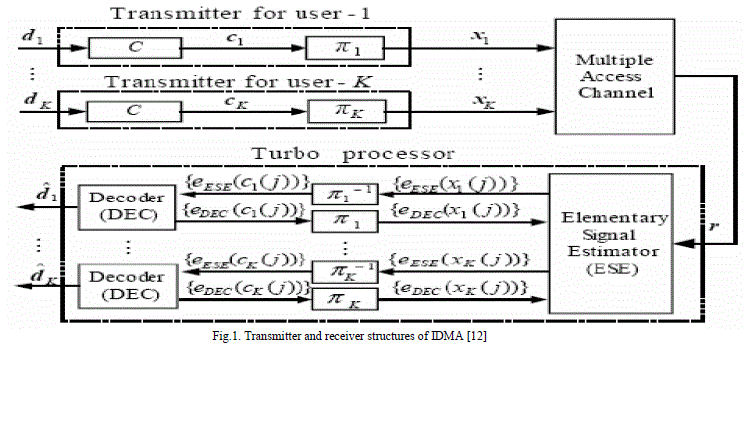 |
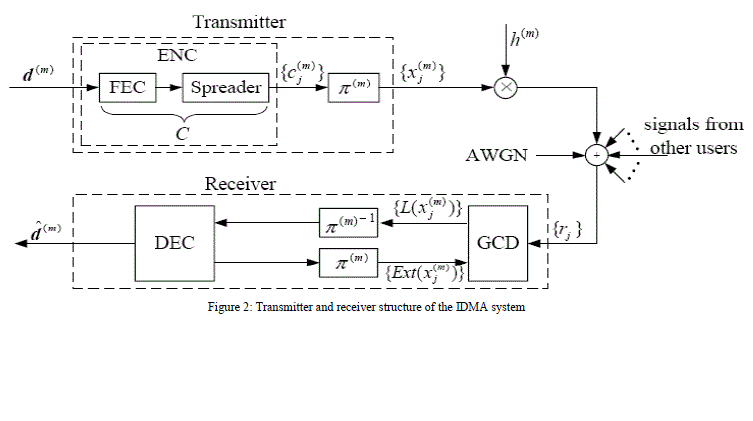 |
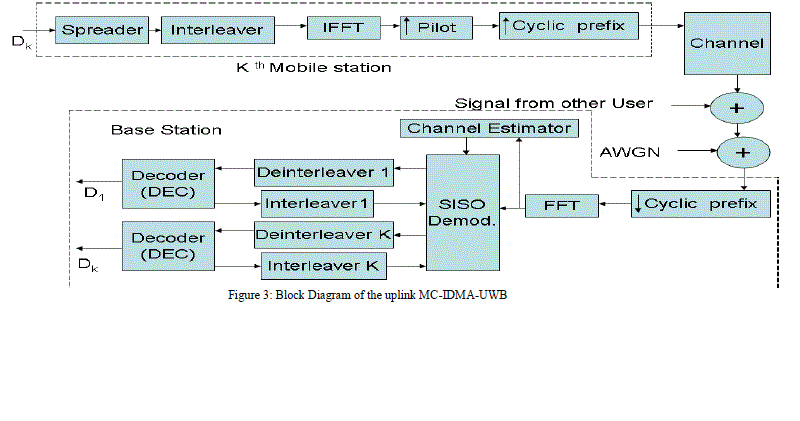 |
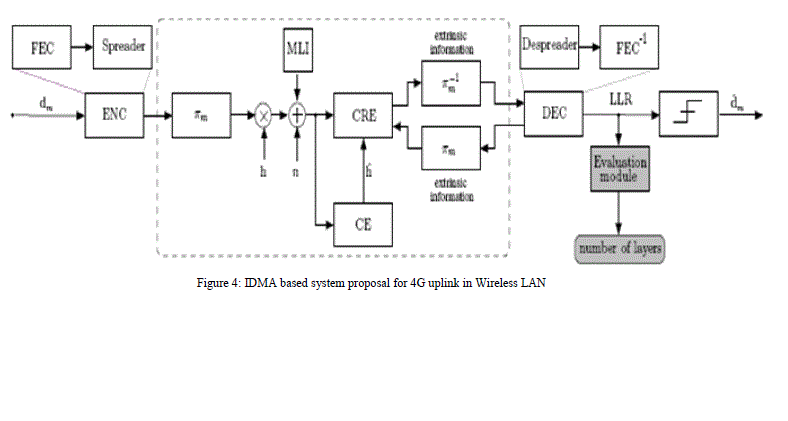 |
| Figure 1 |
Figure 2 |
Figure 3 |
Figure 4 |
|
| |
References
|
- M. Moher and P. Guinand, “An iterative algorithm for asynchronous coded multi-user detection,” IEEE Commun. Lett., vol. 2, pp. 229–231,Aug. 1998.
- F. N. Brannstrom, T. M. Aulin, and L. K. Rasmussen, “Iterative decoders for trellis code multiple-access,” IEEE Trans. on Communs., vol. 50, pp. 1478–1485, Sept. 2002.
- A. Tarable, G. Montorsi, and S. Benedetto, “Analysis and design of interleavers for CDMA systems,” IEEE Commun. Lett., vol. 5, pp. 420–422, Oct. 2001.
- S. Brück, U. Sorger, S. Gligorevic, and N. Stolte, “Interleaving for outer convolution codes in DSCDMA Systems,” IEEE Trans. Commun.,vol. 48, pp. 1100–1107, July 2000.
- S. Verdú and S. Shamai, “Spectral efficiency of CDMA with random spreading,” IEEE Trans. Inform. Theory, vol. 45, pp. 622–640, Mar.1999.
- C. Berrou and A. Glavieux, “Near Shannon limit error correcting coding and decoding: Turbo-codes,”IEEE Trans. Commun., vol. 44, pp.1261–1271, Oct. 1996.
- L. Liu, W. K. Leung, and Li Ping, “Simple chip-by-chip multi-user detection for CDMA systems,” in Proc. IEEE VTC-Spring, Korea, Apr.2003, pp. 2157-2161.
- A Simple Approach to Near Optimal Multiuser Detection: Interleave-Division Multiple-Access, L. Ping, L. Liu, and W. K. Leung, Proc.IEEEWCNC 2003-Wireless Communications and Networking Conf.,New Orleans, LA, USA, 2003, pp. 391–396.
- A simple approach to near-optimal multiuser detection: interleave division multiple-access. Li Ping; Lihai Liu; Leung, W.K. WirelessCommunications and Networking, 2003. WCNC 2003. 2003 IEEE Volume 1, Issue , 16-20 March 2003 Page(s): 391 - 396 vol.1
- Analysis and design of interleavers for CDMA systems, Tarable, A.;Montorsi, G.; Benedetto, S. Communications Letters, IEEE Volume5,Issue 10, Oct 2001 Page(s):420 - 422
- Interleave-Division Multiple Access, Li Ping, Lihai Liu, K. Y. Wu, and W. K. Leung, IEEE Trans. Wireless Commun., Vol. 5, No. 4, Apr.2006, pp. 938-947.
- Iterative detection of interleaver-based space-time codes, Wu K. Y.,Leung W. K., Liu Lihai, Li Ping, IEICE Trans. on Commun., vol. E87- B, no. 11, pp. 3173-3179, Nov. 2004.
- Turbo performance of low-complexity CDMA iterative multiuser detection, S. Schlegel and Z. Shi, in Proc 2003 Int. Sym. Turbo Conference, Brest, France, Sept. 2003, pp. 203–206.
- Li Ping, Lihai Liu, Keying Wu, W. Leung,”Interleave Division Multiple Access”IEEE Transactions On Wireless Communications, Vol. 5, No. 4, pp. 938-947, April 2006
- W. K. Leung, K. Y. Wu, and Li Ping, “Interleave Division multiplexing Space-Time Codes,” in Proc. ISIT’03, Yokohama , Japan, June 2003, pp.354.
- Li Ping , K. Y. Wu, W. K. Leung, and, “A simple unified approach to nearly-optimal detection and space-time coding,” in Proc. ITW’02,Bangalore , India, Oct. 2002, pp. 53-56.
- M. C. Reed and P. D. Alexander, “Iterative multi-user detection using antenna arrays and FEC on multipath channels,” IEEE J. Select. Areas Commun., vol. 17, pp. 2082–2089, Dec. 1999.
- A. AlRustamani, A. D. Damnjanovic, and B. R. Vojcic, “Turbo greedy multi-user detection,” IEEE J. Select. Areas Commun., vol. 19, pp.1638–1645, Aug. 2001
|